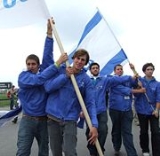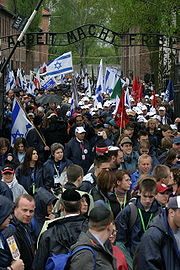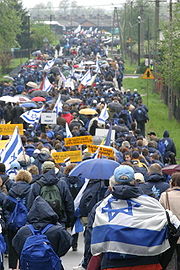
March of the Living
Encyclopedia



Poland
Poland , officially the Republic of Poland , is a country in Central Europe bordered by Germany to the west; the Czech Republic and Slovakia to the south; Ukraine, Belarus and Lithuania to the east; and the Baltic Sea and Kaliningrad Oblast, a Russian exclave, to the north...
, where they explore the remnants of the Holocaust. On Holocaust Memorial Day (Yom HaShoah
Yom HaShoah
Yom HaZikaron laShoah ve-laG'vurah , known colloquially in Israel and abroad as Yom HaShoah and in English as Holocaust Remembrance Day, or Holocaust Day, is observed as Israel's day of commemoration for the approximately six million Jews and five million others who perished in the...
), thousands of participants march silently from Auschwitz to Birkenau, the largest Nazi concentration camp complex built during World War II
World War II
World War II, or the Second World War , was a global conflict lasting from 1939 to 1945, involving most of the world's nations—including all of the great powers—eventually forming two opposing military alliances: the Allies and the Axis...
.
The program was established in 1988 and takes place annually for two weeks around April and May, immediately following Passover. Marchers come from countries as diverse as Panama
Panama
Panama , officially the Republic of Panama , is the southernmost country of Central America. Situated on the isthmus connecting North and South America, it is bordered by Costa Rica to the northwest, Colombia to the southeast, the Caribbean Sea to the north and the Pacific Ocean to the south. The...
, Turkey
Turkey
Turkey , known officially as the Republic of Turkey , is a Eurasian country located in Western Asia and in East Thrace in Southeastern Europe...
, Estonia and New Zealand
New Zealand
New Zealand is an island country in the south-western Pacific Ocean comprising two main landmasses and numerous smaller islands. The country is situated some east of Australia across the Tasman Sea, and roughly south of the Pacific island nations of New Caledonia, Fiji, and Tonga...
.
Commemoration of World War II death marches
At the climax of the program is the March, which is designed to contrast with the death marches which occurred towards the end of World War IIWorld War II
World War II, or the Second World War , was a global conflict lasting from 1939 to 1945, involving most of the world's nations—including all of the great powers—eventually forming two opposing military alliances: the Allies and the Axis...
. When Nazi Germany
Nazi Germany
Nazi Germany , also known as the Third Reich , but officially called German Reich from 1933 to 1943 and Greater German Reich from 26 June 1943 onward, is the name commonly used to refer to the state of Germany from 1933 to 1945, when it was a totalitarian dictatorship ruled by...
withdrew its soldiers from forced-labour camps, inmates – usually already starving and stricken by oppressive work – were forced to march hundreds of miles further west, while those who lagged behind or fell were shot. The March of the Living, in contrast to the death marches, serves to illustrate the continued existence of world Jewry despite Nazi Germany's attempts at their obliteration.
After spending a week in Poland visiting other sites of Nazi Germany's persecution and former sites of Jewish life and culture, many of the participants in the March also travel on to Israel where they observe Yom Hazikaron (Israel's Remembrance Day) and celebrate Yom Haatzmaut (Israel's Independence Day).
Educational value
The March of the Living is mainly aimed at Jewish high schoolHigh school
High school is a term used in parts of the English speaking world to describe institutions which provide all or part of secondary education. The term is often incorporated into the name of such institutions....
students and its goals are both universal (against indifference, racism and injustice) and particular (against anti-semitism, and to strengthen their sense of Jewish identity).
A key element of the program is the participation of Holocaust survivors who share the memory of their war-time experiences with the students, while they are still well enough to participate in this challenging two week trip of the young.
Though the vast majority of participants in the March of the Living are Jewish high school students from different countries including Israel, there are many non-Jewish groups in attendance, along with adult groups such as the Polish Friends of Israel, Japan's Bridges for Peace and others.
Supplementary programs
In recent years the March of the Living (MOL) has attempted to broaden its focus from only concentrating on the Holocaust, and include other program content in the Poland portion of the trip. These elements include: celebrating Jewish life before the war, establishing dialogue with Polish students, meeting with Polish Righteous among the NationsPolish Righteous among the Nations
Polish citizens have the world's highest count of individuals awarded medals of Righteous among the Nations, given by the State of Israel to non-Jews who saved Jews from extermination during the Holocaust...
, and connecting with the contemporary Polish Jewish community.
The March of Remembrance and Hope
March of Remembrance and Hope
The March of Remembrance and Hope is a program designed for university and college students of all religions and backgrounds. The program takes place in mid-May, and includes a two-day trip to Germany, followed by a five day visit to Poland. The international MRH program was founded in 2001 by Dr...
(MRH) is a program designed for university/college students of all religions and backgrounds. This program, founded in 2001, takes place in May, and in recent years, has included a 2 day trip to Germany, before the 5 day Poland portion of the trip. The purpose of the March of Remembrance and Hope is to teach students of different religious and ethnic backgrounds about the dangers of intolerance through the study of the Holocaust and other World War II genocides, and to promote better relations among people of diverse cultures. Holocaust survivors also participate in the March of Remembrance and Hope program. Since its inception students of a wide variety of religions and ethnicities have taken part.
External links
- http://www.motl.org
- http://www.marchoftheliving.org Canadian organization
- http://www.marchadelavida.com.mx Marcha de la Vida México
- http://www.remembranceandhope.com
- March of the Living International
- http://www.viaje.co.il/marcha
- Marcha da Vida - Brasil
- BBC article about the March of Living, 2005
- Comment by Tad Taube in The ForwardThe ForwardThe Forward , commonly known as The Jewish Daily Forward, is a Jewish-American newspaper published in New York City. The publication began in 1897 as a Yiddish-language daily issued by dissidents from the Socialist Labor Party of Daniel DeLeon...
, May 5, 2006 - http://www.cjnews.com/index.php?option=com_content&task=view&id=11803&Itemid=86
- http://www.cse.edu/blog/index.php/2007/02/09/college-of-saint-elizabeth-student-promotes-prejudice-reduction-at-the-united-nations-annual-holocaust-day/#more-99

